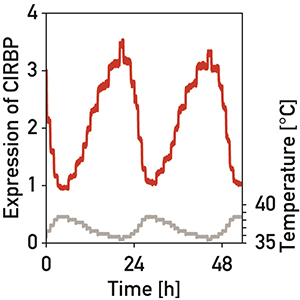The end justifies the means, even at the cellular level

Each of our cells is endowed with a miniature clock composed of a set of ‘clock genes’. During the day, the expression of these genes varies, and this fluctuation influences many biological functions, including body temperature. In turn, our body temperature acts on the daily production of a protein called CIRBP, which will reinforce the activation of certain clock genes. The loop is thus completed. A team of biologists at the University of Geneva (UNIGE), in collaboration with researchers at the Ecole Polytechnique Fédérale de Lausanne (EPFL), Switzerland, deciphered how, in this complex loop, the cell succeeds in producing the right amount of CIRBP protein during the day. This protein plays an essential role in the development of certain cancers, as it can activate or inhibit the proliferation of malignant cells. The results on temperature-dependent CIRBP gene expression are published in the journal Genes and Development.
Various biological functions, such as body temperature, fluctuate daily on a regular basis because they are regulated by internal clocks. These are composed of a family of ‘clock genes’ whose activity reaches a peak every twenty-four hours. Internal clocks, which are present in most cells, are synchronized by a central clock located in the brain and adjusted by light-dark cycles.
The team of Ueli Schibler, professor emeritus at the Department of Molecular Biology of the UNIGE Faculty of Science, discovered some years ago that temperature cycles drive the rhythmic production of a protein called CIRBP, whose quantity peaks in the morning when the body temperature is at its lowest. ‘This protein is essential to amplify the activation of certain clock genes. In addition, it is an important modulator of healthy or malignant cell proliferation’, says the biologist.
A body temperature simulator
In collaboration with the group of Felix Naef at EPFL, the researchers studied the mechanisms enabling cells to adjust their production of CIRBP. ‘We used a device we developed to expose cells to simulated body temperatures cycles. We then followed the different stages of expression of the gene encoding the CIRBP protein’, explains Ivana Gotic, a researcher from the Geneva team and first author of the study.
Within the cell, genes are transcribed into copies called pre-messenger RNAs. The latter are then converted with ‘molecular scissors and glue’ into mature messenger RNAs, which contain the final instructions to form proteins. ‘We expected the level of CIRBP pre-messenger RNAs to increase at low temperature, since it is when the temperature is at its lowest that the protein is produced in greatest amounts. However this most parsimonious scenario proved to be wrong. Surprisingly, the level of pre-messenger RNAs remains constant, and only the quantity of mature RNAs depends on body temperature. We still had to figure out why’, notes Ueli Schibler.
A small, but crucial difference
The researchers have unveiled a novel mechanism while solving this riddle. ‘At low temperature, most CIRBP pre-messenger RNAs become mature. However, with increasing temperature, only a portion of the pre-messengers is transformed into mature RNAs, while the rest is destroyed’, explains Ivana Gotic. This is how the cell regulates its CIRBP production rate in relation to body temperature. Depending on the latter, the cell sets the fraction of pre-messenger RNAs that will be transformed into mature RNA. Moreover, experiments performed on all genes transcribed within the cell demonstrated that the same mechanism is at work for many temperature-sensitive genes.
Body temperature differences of 1°C to 3°C found between the morning and the evening in humans and mice have therefore important implications. ‘Such a small variation can result in cycles of gene expression with large amplitudes. CIRBP, for example, induces the daily production of a protein that is involved in the elimination of toxins and in drug metabolism. Thus, as demonstrated in mice, the efficacy and toxicity of certain treatments strongly varies depending on when they are administered during the day’, concludes Ueli Schibler.
Contact: Ueli Schibler +41 22 367 13 08
15 Sept 2016